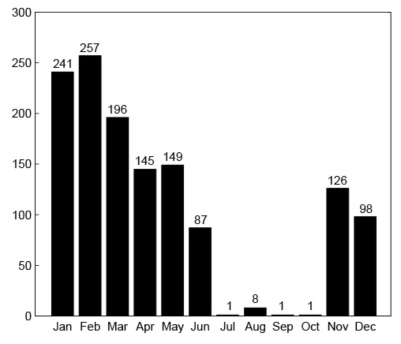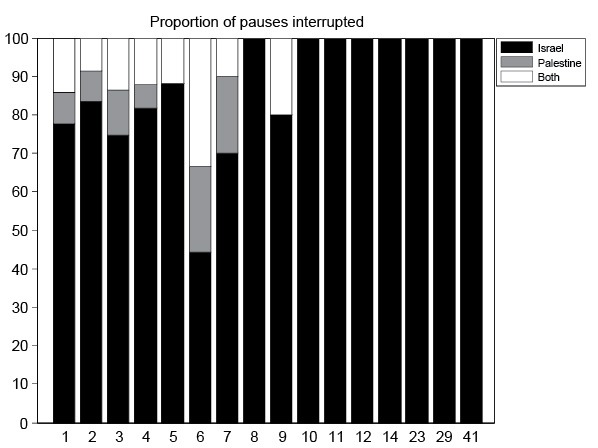By Nancy Kanwisher, Johannes Haushofer, and Anat Biletzki
The Huffington Post, January 6, 2009
As Israel and Palestine suffer a hideous new spasm of terror, misery, and mayhem, it is important to ask how this situation came about. Perhaps an understanding of recent events will afford lessons for the future.
How did the recent ceasefire unravel? The mainstream media in the US and Israel places the blame squarely on Hamas. Indeed, a massive barrage of Palestinian rockets were fired into Israel in November and December, and ending this rocket fire is the stated goal of the current Israeli invasion of Gaza. However, this account leaves out crucial facts.
First, and most importantly, the ceasefire was remarkably effective: after it began in June 2008, the rate of rocket and mortar fire from Gaza dropped to almost zero, and stayed there for four straight months (see Figure 1, from a factsheet produced by the Israeli consulate in NYC). So much for the widespread view, exemplified in yesterday's New York Times editorial that: "There is little chance of restraining Hamas without dealing with its patrons in Syria and Iran." Instead, the data shows clearly that Hamas can indeed control the violence if it so chooses, and sometimes it does, for long periods of time.
Second, and just as important, what happened to end this striking period of peace? On November 4th, Israel killed a Palestinian, an event that was followed by a volley of mortars fired from Gaza. Immediately after that, an Israeli air strike killed six more Palestinians. Then a massive barrage of rockets was unleashed, leading to the end of the ceasefire.

Figure 1. Number of Palestinian rockets fired in each month of 2008 (adapted from The Israeli consulate in NYC [pdf])
Thus the latest ceasefire ended when Israel first killed Palestinians, and Palestinians then fired rockets into Israel. However, before attempting to glean lessons from this event, we need to know if this case is atypical, or if it reflects a systematic pattern.
We decided to tally the data to find out. We analyzed the entire timeline of killings of Palestinians by Israelis, and killings of Israelis by Palestinians, in the Second Intifada, based on the data from the widely-respected Israeli Human Rights group B'Tselem (including all the data from September 2000 to October 2008).
We defined "conflict pauses" as periods of one or more days when no one is killed on either side, and we asked which side kills first after conflict pauses of different durations. As shown in Figure 2, this analysis shows that it is overwhelmingly Israel that kills first after a pause in the conflict: 79% of all conflict pauses were interrupted when Israel killed a Palestinian, while only 8% were interrupted by Palestinian attacks (the remaining 13% were interrupted by both sides on the same day). In addition, we found that this pattern -- in which Israel is more likely than Palestine to kill first after a conflict pause -- becomes more pronounced for longer conflict pauses. Indeed, of the 25 periods of nonviolence lasting longer than a week, Israel unilaterally interrupted 24, or 96%, and it unilaterally interrupted 100% of the 14 periods of nonviolence lasting longer than 9 days.

Figure 2. For conflict pauses of different durations (i.e., periods of time when no one is killed on either side), we show here the percentage of times from the Second Intifada in which Israelis ended the period of nonviolence by killing one or more Palestinians (black), the percentage of times that Palestinians ended the period of nonviolence by killing Israelis (grey), and the percentage of times that both sides killed on the same day (white). Virtually all periods of nonviolence lasting more than a week were ended when the Israelis killed Palestinians first. We include here the data from all pause durations that actually occurred.
Thus, a systematic pattern does exist: it is overwhelmingly Israel, not Palestine, that kills first following a lull. Indeed, it is virtually always Israel that kills first after a lull lasting more than a week.
The lessons from these data are clear:
First, Hamas can indeed control the rockets, when it is in their interest. The data shows that ceasefires can work, reducing the violence to nearly zero for months at a time.
Second, if Israel wants to reduce rocket fire from Gaza, it should cherish and preserve the peace when it starts to break out, not be the first to kill.
Nancy Kanwisher is the Ellen Swallow Richards Professor of Cognitive Neuroscience at the Massachusetts Institute of Technology. Professor Anat Biletzki has been teaching in the philosophy department in Tel Aviv University since 1979. She is a leading Israeli human rights activist and former chairperson of the board of B’Tselem - the Israeli Information Center for Human Rights.





No comments:
Post a Comment